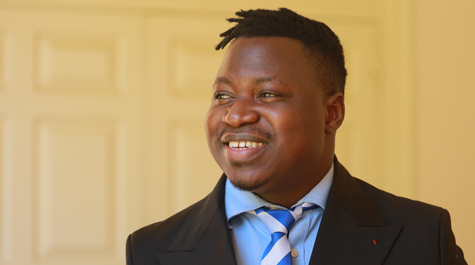Lasisi is going to Dumbarton Oaks, to research the ‘Landscape of Power’ of Ijebu-Ode
The royal palace at Ijebu-Ode was the center of economic, political and ritual life in the great Ijebu kingdom for a millennium, maybe more.
Olanrewaju Lasisi explains that the palace was not only the metaphorical center, but also the literal center of the kingdom.
“The capital of the Ijebu kingdom is located at the geographical center —the exact center — of the kingdom,” Lasisi explained. “Now, that center also has another wall, another enclosure surrounding the center. So now we are talking about concentric walls, the large one, and then another one in the center.”
Lasisi is a Ph.D. candidate in William & Mary’s Department of Anthropology. He has done extensive field work and scholarship on the history, archaeology and oral traditions of the Ijebu kingdom, a realm that dominated a great portion of what is now Nigeria until 1888.
He recently was awarded a Junior Fellowship in Garden and Landscape Studies by Dumbarton Oaks, a research institute connected with Harvard University. Through the fellowship, Lasisi will be in residence at Dumbarton Oaks, using their library and other resources to focus on his dissertation research, “Landscapes of Power: A Historical Archaeology of Ijebu-Yoruba Palatial Urbanscape, AD 1000-1900.”
Lasisi’s “landscape of power” refers specifically to the ancient royal palace at the kingdom’s capital. His research encompasses not just the gardens associated with the palace landscape, but the entirety of the Ijebu concentric circles. He notes that the outer wall-ditch complex, known as Sungbo Eredo, is nearly 100 miles in circumference. Lasisi said Sungbo Eredo could well be the longest single earthwork in the world.
Ijebu is an ancient place — Sungbo Eredo was built in the late fourteenth or early 15th century. Lasisi said the first mention of it by a European came from the Portuguese explorer Pacheco Pereira who visited the region in the 15th century. In its heyday, the kingdom was a major player in the Atlantic mercantile world, trading slaves and a valuable kind of cloth and other goods.
But, Lasisi said, some remnants of the indigenous practices are still being practiced to this day, but most of the knowledge of the connection has been lost. People still live there, and Ijebu still has a monarch, known as the Awujale. Lasisi’s goal is to determine which polity over the centuries was responsible for development of the various features of Ijebu. He can draw his data not only from the archaeological remains, but also from the few practices that have continued through the ages.
“For example, one of them is an annual festival called the Agemo,” he explained. “It is about the inner and outer world.”
The inner world, of course is Ijebu-Ode, the capital. Between the inner wall and the outer wall are 16 towns. Lasisi said that each town sends a priestly representative to Ijebu-Ode to celebrate Agemo.
“Basically, they’re paying tribute to the king. So, each year they march down to the palace complex, crossing the inner wall, to pray with the king,” Lasisi said.”
Lasisi points out that Agemo is just one such ritual festival is held on the ancient palace grounds, the “landscape of power” that is the object of his research. “The new palace is somewhere else,” he said.
He explained that the Ijebu society has traditionally included astronomical aspects in their rituals and practices — the traditional palace complex faces true east, to catch the rising sun. His archaeology has uncovered interesting connections between the past and present.
For instance, Lasisi’s archaeology at the palace courtyard has uncovered examples of ceramic pavement. Some are decorative and representative, but one has a stunning connection to a current ritual practice.
“It’s a kind of a sundial,” he explained. “One segment is facing the direction of the sun, with a V-shape and many little triangles.”
Knowing the Ijebu traditional incorporation of celestial phenomena into ritual practices, Lasisi took a compass to the sundial pavement.
“I found out that it follows the sun from one equinox to the other,” he said. “It is so perfectly organized. On March 21 and September 21-24, you see the alignment with the solstice, which coincides with the Obinrin Ojowu festival, and then in June 21, you see the equinox that coincides with the launching of the Agemo festival. All right there on a pavement in the floor.”
The sundial pavement had long been covered over, but the priests of the Ijebu people understood the significance of the space in that portion of the palace complex. Lasisi said each year, the Obinrin Ojowu priests conduct a ritual that involved a solar observation.
“And they set up the Obinrin Ojowu deity as a gnomon right on the part of the V-shaped pavement that casts the shadow, right over or very near to where I uncovered that sundial,” Lasisi said. “They had no idea that there is a pavement underneath, but they’ve been doing that since time immemorial. This is just one of the examples of a continued tradition with a lost understanding of the dynamics of the practices.”















